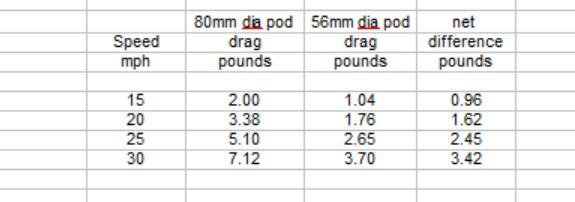Here is a numerical design tool which is really helpful for designing hydrofoils. This Excel spreadsheet was created by Zach Hoisington, a senior aircraft/aerodynamics engineer.
With this tool you can adjust speed, weight, wing size, motor pod size etc. Not only does this tool calculate total drag, it gives you a break down of where the drag is coming from to help you know where to focus your drag reduction efforts.
You can even estimate the stall speed of your design. The design tool calculates the required Cl for a particular design/weight and speed. By gradually reducing speed you will see a point Where Cl is above 1.00 and begins to climb very fast…the approximate stall speed.
The example below is my current design which I optimized for minimum drag at 15 mph. For optimized (minimum drag) at higher speeds, shorter wing spans are better.
Once we have more data from actual foils, it would be great to compare real world numbers to the predictions given by this spread sheet.
Here is the dropbox link for this spread sheet: Dropbox - Hydrofoil medium AR.xls - Simplify your life
Example of my current design at 15 mph.
7 Likes
I made another model with a lower aspect ratio foil shown below. All else is the same as the example shown in the first post. Then I ran the spreadsheet for the low and medium aspect ratio foils to compare the predicted drag from stall speed up to about 30 mph. The medium aspect ratio wing is the clear winner up to about 27 mph as shown in the chart below:
Design tool with low aspect ratio wing
.
.
Comparative performance of the two foils
2 Likes
I used the design tool to see the effect of motor pod diameter as a function of speed. A smaller diameter motor pod always has less drag…as expected. But at the lower speeds the extra drag of a larger pod is pretty small. This analysis helped me decide that for my lower speed build, a large direct drive out-runner could be a good choice.
At my design cruise speed of 15 mph the larger pod only adds 1 lb. of drag. This is greatly offset by the thrust efficiency of the large out-runner with a well matched propeller. In the flume testing, the Alien c80100 with a well matched prop drew less than 10 amps to make 20 lbs. of thrust. If the numbers are correct, a 20 Ah battery should give 2 hours of flight time with my design.
If I were designing for higher speeds a smaller motor with reduction gear and a smaller pod would be more attractive if the drive system was efficient enough overall.

That is a great tool. Thank you for that. Is anybody already converting this into metric units? If so, please upload it.
I’ve contacted Zach to see if he is willing to create a metric version of this design tool. I’ll post when I hear back.
Zach kindly said yes to a metric version of the design tool. Should have this within a week.
4 Likes
Congratulations for all this work . Did you eventually get any news from Zach and his metric version ?
I’ll poke him and see if he can finish the metric version.
1 Like
Zach sent me a draft of the metric/SI version this AM. It will actually be a single version where the user selects SI or Imperial units. I played with it a little, looks like it works well. Zach wants to “triple check” everything on the design tool and then it will be released. Won’t be long.
2 Likes
Hello!,
I am new in this forum but this issue is the most I am interested in.
Is it finished?
Thank you for the response
Hey Guys, Here is the metric/imperial units version. Big thanks to Zach for creating this!! Just click on the yellow “Imperial Units” cell to toggle to metric units. Please note the other cell numerical values do not change so you will need to input your own design parameters such as speed wing span etc.
Good luck with the design tool and your designs and your builds!
Hydrofoil Design Tool 2.2.xls
7 Likes
Thanks for the metric version, it hurts my eyes to see imperial,
4 Likes
Thanks @Winging_it ! Have you tested it ? I have a blank page when I open it. Anybody else with the same problem ?
I just re-checked it. The download from DropBox and the spreadsheet work fine for me. I tried the design tool/spreadsheet in both Excel and in Open office Calc with no problems.
I found the problem which may occur to other persons.
I right clicked on your link to download it. My browser offered me to download a hybrid xls.html file which I didn’t notice.(size 327kb). Explanation: it is the Dropbox page of your file in html format that neither Excel nor any other spreadsheet can read…
Then, I left-clicked on the link, the xls file opened in the Dropbox browser interface then I selected “Download” in the top right corner. I got a native and xls file (size 204 kb).
Has anyone checked the error in this spread sheet by comparing the results of it to CFD or actual testing? Also, @Winging_it Drag is a force not a mass, you should write lbf (force pound) instead of lbs for a clearer under standing.